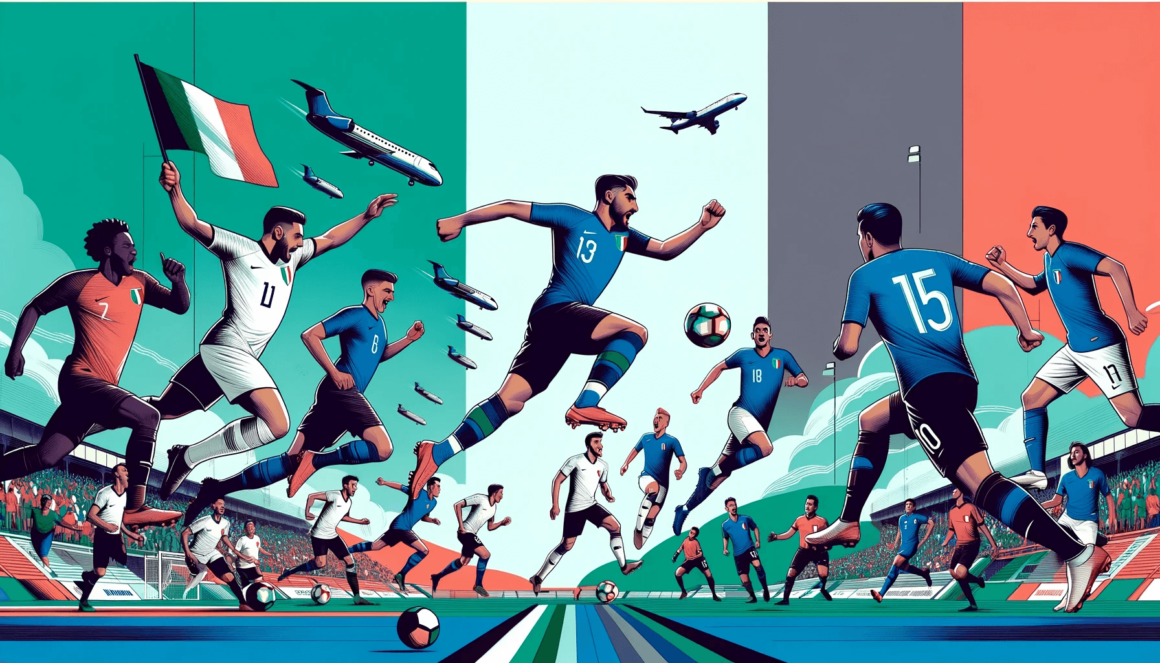Catenaccio: The Italian Defense
When most people think of Italian football, they think of the free-flowing, attacking soccer played by teams such as Juventus, AC Milan, and Inter Milan. However, there is another side to Italian football – the defensive system called “catenaccio” or the “door-bolt.” This article will discuss the origins and use of this soccer tactic, some famous matches in which it was used, and how it remains relevant in terms of soccer tactics today.
History of the Door-Bolt

Catenaccio is a system of soccer in which the aim is to keep a clean sheet, rather than score goals. The name comes from the Italian for door-bolt, which gives an indication of how tight the defense is meant to be. The system was first used in the 1930s by Swiss coach Karl Rappan, who was managing Grasshopper Club Zurich and the Swiss national team at the time.
The catenaccio style of football became famous in the 1960s when it was used by Italian teams such as Inter Milan and Juventus. Helenio Hererra, who coached Inter during its Grande Inter years, improved on the defense setup of Karl Rappan’s team.
Rappan used four defenders who played a man-on-man marking style, and in front of them was a midfielder who served as the playmaker. With Inter, Hererra added a fifth defender, a “sweeper” who would stop any opposing player who managed to get through the center-backs.
These Italian teams were very successful using this system, with Inter winning two consecutive European club cups: 3-1 against Real Madrid in 1963/64 and 1-0 at home against Benfica in 1964/65. If you’re familiar with soccer facts, you’ll know just how impressive winning back-to-back European titles is.
Nowadays, the defensive Catenaccio system is not used nearly as much as it once was. This is because soccer has evolved and become more attacking, with teams looking to score goals rather than just keep a clean sheet. However, it is still used on occasion by teams who are looking to protect a lead, or who are playing against a team with very good attacking players.
End of an Era
By the end of the ‘60s, some shortcomings of this football defense style came to light. The Dutch free-flowing attacking style, in which players didn’t stay in one set position, completely confused the Italians, who based their system on man-to-man marking.
With attackers, midfielders, and defenders switching places on the Dutch side, it rendered the Italian setup completely ineffective. And by the beginning of the 1970s, the Ajax team led by Rinus Micheals would convincingly beat Inter and Juventus in the European Cup Finals in 1972 and 1973 respectively.
The Dutch strategy of “Total Football” introduced a new tempo of soccer that made it hard for catenaccio to counter. It was time for the door-bolt to evolve into a more flexible mechanism.
By the 1970s the Italians had come up with an alternative tactical approach called zona mista or “mixed zone.” It included elements of zone marking alongside man-to-man tagging, so as to make defensive play more adaptable to various attacking strategies.
What Makes it Different from Other Styles of Defense?
There are a couple of unique pieces to the puzzle of the Catenaccio strategy that set it apart from similar systems. First of all, what revolutionized the approach was the role of the sweeper.
The sweeper – or the libero, meaning “free man” – is a defensive position. Primarily pinned to the center-half position, the libero can move freely up and down the defensive line trying to intercept opposition passes.
This defense relies on three defenders to mark their players from the opposition. The sweeper then comes in to pick up loose balls or double on an attacker when needed.
This football style of play doesn’t only mean preventing the opponent from scoring; there is also an attacking component to the tactic that some teams copying this style seem to miss. Goal-scoring opportunities typically come from counter-attacks and long passes launched from the back of the defense.
In the modern era, players such as Franco Baresi, Robert Koeman, and Fernando Hiero have occasionally been deployed in this position exactly because their passing skill complements their ability to defend and intercept passes.
Of all the best players to have played sweeper over the past few decades, Baresi was probably the most complete sweeper in this football style.
He would regularly mess up the plans of the opposition, picking up any loose balls from the attack, and he had the ability to move the defensive lines and intercept passes in the midfield as well. He also knew when to push forward and join the counter-attack. He was a libero in the full sense of the word.
With his 20-year-long career at AC Milan and playing for the Italian national team, he is the player with the most experience playing in the sweeper position and a prime example of what a skillful libero can mean to a team.
Big Tournament Comebacks
After it looked like it was mostly done and dusted on the big stage, catenaccio made its comeback in grand style. The Italian team of 1982 – with Baresi in the libero position – won against West Germany 3-1 in the final to secure Italy’s third World Cup.
In 1990, the West German team returned the favor, winning in Italy. Led from the bench by the legendary Franz Beckenbauer and with captain Lothar Matthäus in the role of the sweeper, the West Germans beat Argentina 1-0.
With the only goal scored from a penalty late in the game, the West Germans managed to restrain the feisty Argentinian team with Maradona and Caniggia in the attack.
The catenaccio defense system also played a role in what is perhaps the greatest underdog story in the modern era of soccer: Greece winning the Euro 2004. It was the first Euro that the Greek national team had participated in since 1980, and everybody thought that just coming to Portugal to participate was an achievement in itself.
The team was led by the experienced Otto Rehhagel, also known as King Otto. From the start, the Greeks were up against some difficult opponents in a very strong group with Spain, Russia, and the host Portugal. On their way to the final, the Greeks also clashed with reigning European champions France and took on Portugal again in the final to win the title.
Modern Era
It seems that catenaccio football has left such a strong mark on European football that any tactic based on a strong defense gets labeled by this name. In recent years, some defensive strategies – as well as some versions of the tiki-taka tactic – have been labeled as anti-football for apparently not emphasizing scoring enough.
Chelsea’s style of play under Jose Mourinho has often been called “parking the bus” in comparison to the attractive “gegenpressing” style of play of the Liverpool team, which those who love the game tend to enjoy more.
Catenaccio vs Parking the Bus
“Parking the bus” has often been used to refer to Chelsea’s style of soccer under Jose Mourinho. Although the results were often good enough to keep Chelsea fans happy, the team and its manager were criticized for overly defensive play that could be labeled anti-football. Critics said that Chelsea snuffed out all the excitement and class from the game if the team found itself within reach of a favorable result.
Ironically, it was Mourinho himself who first introduced the term to the public following a Chelsea-Tottenham match. Ultimately, it was Mourinho himself who was dubbed the proverbial bus driver.
The tactic Mourinho’s team actually used was a combination of the man-marking strategy characteristic of catenaccio and the zone-marking approach seen in zona mista. This created the impression of a disciplined squad focused on closing the opposition’s passing lanes and playing a tight defensive game. The “Special One” was never shy about playing for results, but sometimes the game was just unattractive to watch.
Can the game of soccer be beautiful as well as exciting? Johan Cruyff certainly thought so. The famous Dutchman always favored a game that had style, with a certain flow that would give the impression of elegance. Maybe it’s possible to have both, as the great Italian teams have shown over the years.
Bottom Line
Soccer based on a strong defense has long been a trademark of the Italian soccer style, but Italian football is about more than just mere pragmatism and keeping the score low. The country has produced defenders prepared to go all out to save their side, midfielders both skillful and tenacious, and a piercing counter-attack that sums up the Felce Azzurri’s philosophy.
The door-bolt defense system was unbreakable during its heyday in the 1960s. With the Italian approach since being countered by the new attacking styles like Total Football, the italian strategy has had to evolve, but the tenets of its soccer philosophy seem to have endured.
The sweeper system has worked for various teams over the past 70 years since its invention. Indeed, the catenaccio style of soccer is not just a part of distant soccer history, but remains key to the ever-evolving battle of soccer tactics.
FAQ
What does parking the bus mean in soccer?
“Parking the bus” is a term used to describe extremely defensive tactics, whereby the majority of players remain behind the ball when possession is lost. It is often called out by coaches and managers as anti-football, as it relies more on nullifying the chances of the opposition than making proactive plays.
Who invented catenaccio?
Catenaccio is based on the system invented by the Austrian coach Karl Rappan. But the real door-bolt tactic was employed first by Padova under coach Nerreo Rocco, with great emphasis on defense. At the time, the sweeper performed only defensive duties instead of trying to also be a playmaker.
What is the Italian style of play?
Italian teams traditionally put a lot of emphasis on defense. Their style therefore focuses on cutting off opposition attacks, controlling the game through a strong midfield, and attacking via the flanks and with piercing counter-attacks.
Is catenaccio still used?
This style has a considerable reputation in Italian soccer, but it isn’t used often these days. The tactic can give certain teams a chance against a stronger opponent, but it is far from infallible. As such, it’s used every so often as a way to surprise the opponent.
 BC.Game
BC.Game  7Bit
7Bit  Ducky Luck
Ducky Luck  Red Dog
Red Dog